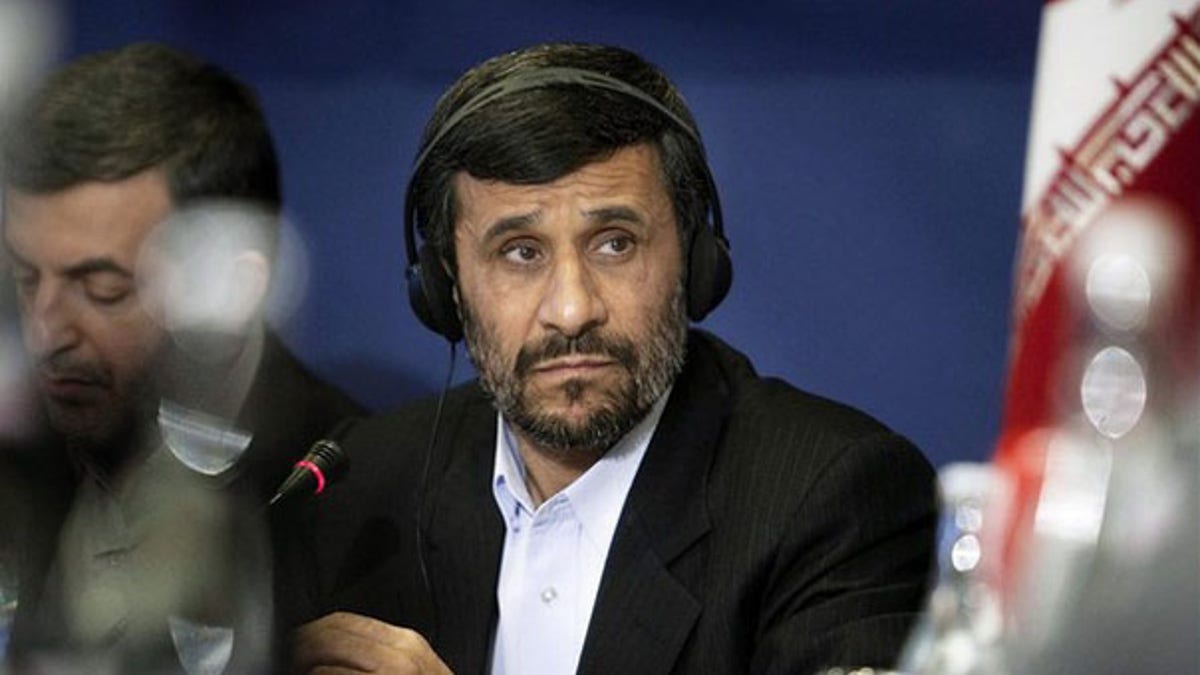
File: Iranian President Mahmoud Ahmadinejad. (Reuters)
Tensions between the U.S. and Iran rose Monday after the Obama Administration quietly increased the capability of land and sea-based missile defenses in several Gulf nations to protect American allies against a potential Iranian strike.
Administration officials said over the weekend that the U.S. was speeding up arms sales to a number of Gulf Arab states and that it had also deployed warships capable of knocking down hostile missiles in flight to the region.
Two senior defense officials told Fox News on Monday that missile-defense systems, including sea-based Aegis destroyers and Patriot missiles, are being sent to the Gulf region. One official said the build-up was "previewed in the president's strategy on missile defense last year."
The moves, which include the sales of anti-missile systems to Saudi Arabia, Qatar, Bahrain and Kuwait, are designed to deter Iran from launching attacks against its Sunni Muslim neighbors and to send a message to Israel that a preemptive strike against Iran is unnecessary.
The deployments come as President Obama enters a new phase in efforts to halt Iran's nuclear program after the failure of a diplomatic offensive. Washington is anxious to get a tough new round of U.N. sanctions against Tehran, something that China and Russia have shown little interest in backing.
The new arms sales build on deals struck by Former President George W. Bush to develop a deterrent among the region's Sunni nations, including Egypt, Jordan and Saudi Arabia, against the predominantly Shia Iran.
The UAE and Saudi Arabia have bought more than $25 billion of U.S. arms in the past two years.
Abu Dhabi has bought $17 billion of U.S. hardware since 2008, including Patriot anti-missile systems, while the UAE as a whole recently bought 80 F-16 jets.
The administration will send a review of ballistic missile strategy to Congress on Monday that frames the larger shifts. Attention to defense of the Persian Gulf region, a focus on diffuse networks of sensors and weapons and cooperation with Russia are major elements of the study, according to documents obtained by The Associated Press.
Russia opposed Bush administration plans for a land-based missile defense site in Eastern Europe, and Obama's decision to walk away from that plan last year was partly in pursuit of new capabilities that might hold greater promise and partly in deference to Russia.
Secretary of State Hillary Rodham Clinton consulted with numerous allies during a visit to London this week. She told reporters that the evident failure of U.S. offers to engage Iran in negotiations over its nuclear program means the U.S. will now press for additional sanctions against the Iranian government.
Gen. David Petraeus, the U.S. Central Command chief who is responsible for U.S. military operations across the Middle East, mentioned in several recent public speeches one element of the defensive strategy in the Gulf: upgrading Patriot missile systems, which originally were deployed in the region to shoot down aircraft but now can hit missiles in flight.
In remarks at Georgetown Law School on Jan. 21, Petraeus said the U.S. now has eight Patriot missile batteries stationed in the Gulf region -- two each in four countries. He did not name the countries, but Kuwait has long been known to have Patriots on its territory.
A military official said Saturday that the three other countries are the United Arab Emirates, Bahrain -- which also hosts the U.S. Navy's 5th Fleet headquarters -- and Qatar, home to a modernized U.S. air operations center that has played a key role in the Iraq and Afghanistan wars.
In a presentation Jan. 22 at the Institute for the Study of War, Petraeus explicitly linked the actions to concerns about Iran.
"Iran is clearly seen as a very serious threat by those on the other side of the Gulf front, and, indeed, it has been a catalyst for the implementation of the architecture that we envision and have now been trying to implement," he said.
He said that "architecture" includes the extra Patriot batteries "that weren't there, say, two years ago."
"Other countries have certainly increased their Patriots, a whole host of different systems; Aegis ballistic missile cruisers are in the Gulf at all times now," Petraeus added.
The Aegis ships are equipped with a missile known as the SM-3, which gained international acclaim in February 2008 when a souped-up version was launched from a Navy cruiser in the Pacific and shot down a failing U.S. satellite in space.
Defense Secretary Robert Gates has spoken publicly about a new approach to missile defenses, both in Europe and the Gulf.
"I don't want to get into it in too much detail," Gates said in September. "but the reality is we are working both on a bilateral and a multilateral basis in the Gulf to establish the same kind of regional missile defense that would protect our facilities out there as well as our friends and allies."
Gates said the adjusted approach is based in part on a belief by U.S. intelligence that Iran has not been progressing as fast as previously believed on development of a long-range ballistic missile, but is concentrating more heavily on short- and medium-range missiles of the sort that the Patriot and the Aegis systems are designed to defend against.
The Times of London and Associated Press contributed to this report.




